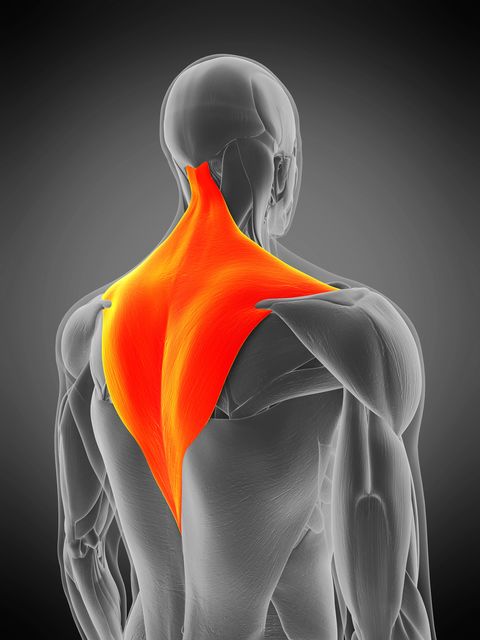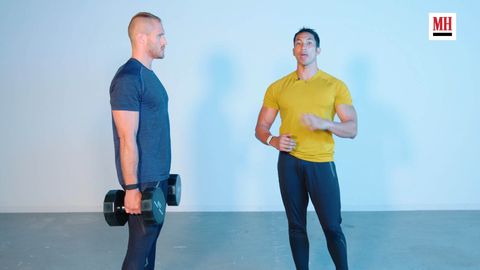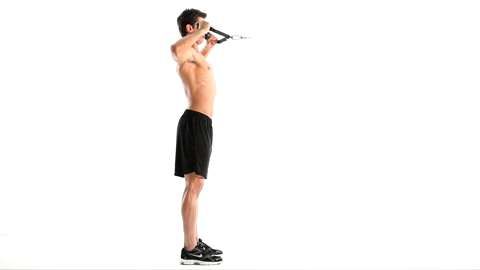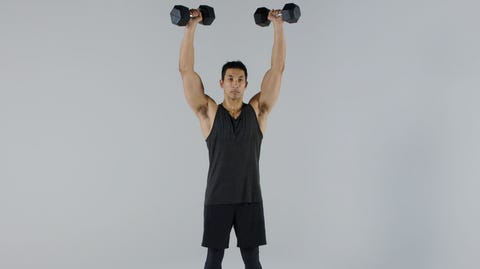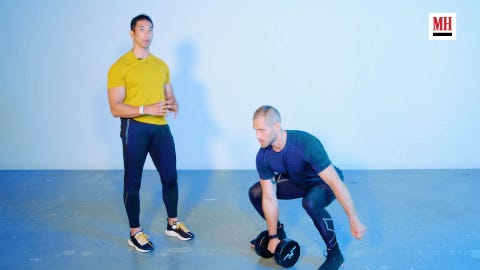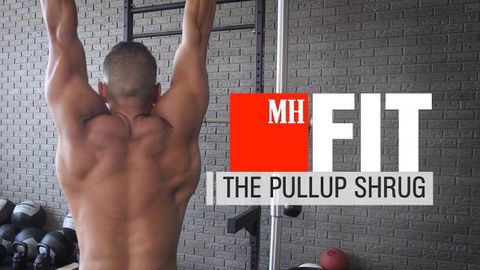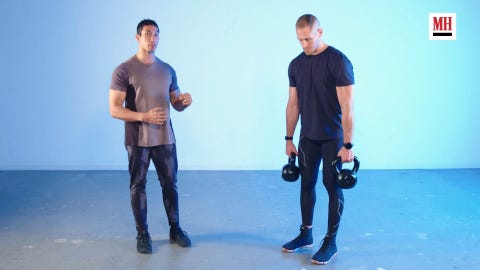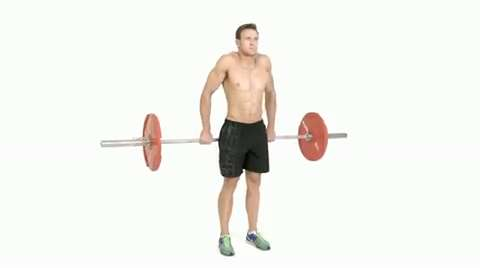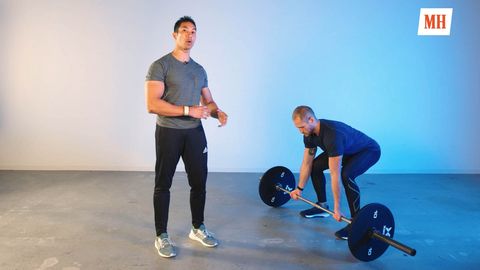Is It Easy to Develop Your Traps
Packing on muscle mass isn't just a matter of blindly picking things up and putting them down. You have to be slightly more strategic than that to build the physique you want. Understanding which muscles should be given attention and the effects your work will have is essential if you're training with the objective to grow a bigger-looking body.
Case in point: the upper body. You might be thinking that you should sink all of your muscle-building efforts into your chest, shoulders, and arms. That's not totally off the mark—but your back needs attention, too, for more than just symmetry's sake. One muscle you should give particular focus is the traps (a.k.a. the trapezius or trapezoid muscles). The long, quadrilateral-shaped muscle, which is composed of three parts (superior, middle, and inferior), takes up a ton of real estate on your upper back.
The functions of the traps make it especially worth your focus. The muscle is big on its own, and you'll add size to your back and shoulders when you take on traps-focused movements—but your other upper body muscles will also benefit from strong traps.
The upper traps support your arms and raise your shoulder blades, while mid and lower traps are essential for scapular retraction, depression, and rotation. Shrugging your shoulders, raising your arms, and other movements use your traps, so training them to be as strong as they can be will help you out in more than just the big back department.
Add these exercise to your upper body training sessions to start building bigger, stronger traps. The ultimate goal: become a traps king.
Farmer's Carry
Heavy carries are some of the best bang for your buck exercises you can do, so it should come as no surprise that your traps stand to benefit from a few loaded laps around the gym. Make sure to keep your shoulders and back engaged throughout, since slouching will kill your back and core gains.
DO IT: Hold a weight (dumbbells or kettlebells will do) in each hand at your sides. Engage your core and back, holding a strong, upright posture. Take even, measured steps, controlling the weight and maintaining your posture for either a set time or distance.
Face Pull
Get your face in on the action with this underrated trap move. The face pull can be performed with a cable machine or even a resistance band, if you're focused on mastering the form to help bulletproof your back and shoulders. "The face pull hits lower traps when done right," says Men's Health Fitness Director Ebenezer Samuel, C.S.C.S., "which is actually super-critical and useful to shoulder health."
DO IT: Set the cable machine or resistance band at a roughly eye-level height. Grab the cable rope handles or the ends of the band in each hand in an underhand grip. Squeeze your shoulder blades to pull toward your face, keeping your elbows high and resisting the urge to lean forward. Pause to squeeze once you pull back as far as you can, then control the cable/bands back to the starting position.
Dumbbell Military Press
This classic exercise is standard shoulder builder—but you'll nail your traps, too. Working with dumbbells gives you an opportunity to work in more shoulder-safe positions, especially because you'll be less inclined to try to lift more weight than you're able to handle by stacking plates on a barbell.
DO IT: Grab a pair of dumbbells and raise them to your shoulders. Brace your core and glutes to set a firm foundation—the biggest mistake you want to avoid if rounding your back under the weight. Make sure to keep your ribs from flaring. Once you're ready to press, make sure that you're not lifting straight up. You want to move in the scapular plane about a few degrees in front of your torso (to keep your rotator cuffs safe) so rotate your elbows out slightly. Squeeze your shoulder blades, then press the weight up.
Dumbbell Snatch
You typically don't think of explosive moves like snatches as back exercises, but posterior muscles like the traps are absolutely essential to proper form. You'll get your whole body engaged to do the dumbbell snatch right, especially as you get the weight up above your head.
DO IT: Start with the dumbbell on the ground in front of you between your legs with your feet wider than shoulder-width apart. Bend at the knees and hinge at the hips and grab the weight an overhand grip. Sit back on your heels, then explode upwards to stand, driving the weight up close to your body. Pull the dumbbell up as if you're zipping a coat, then pull slightly back and land under the weight overhead. Lower the dumbbell to your shoulder slowly to finish the move.
Bent Over Y
The bent over Y is a simple move that can be used as a warmup sans weight, or you can use light dumbbells to work your lower traps. Keep the weight light, though — you might be surprised at how hard the Y can be.
DO IT: Stand with your feet shoulder-width apart, holding light dumbbells with your thumbs facing up. Hinge at the hip to assume a bent over position. Raise your arms in front of you forming the shape of the letter Y, holding the position for a beat. slowly return to the starting position.
Pullup Shrug
This move won't just build your traps—it'll also help you hone your pullup form. You'll also work your lats, so you won't just be isolating one muscle.
DO IT: Hang from a pullup bar, keeping your spine aligned and core tight. Pull your shoulders back and down to extend your head and neck upward. Hold for a count, then lower yourself back into the starting position.
Barbell Shrug
The barbell shrug is the king of all trap-building exercises, according to Tyler English, author of the Men's Health Natural Bodybuilding Bible.
It targets the upper portion of your traps, which are responsible for lifting your shoulder blades.
DO IT: Grab a barbell with an overhand grip that's just beyond shoulder-width apart, and let the bar hang at arm's length in front of your waist. Keeping your back naturally arched, lean forward at your hip about 10 degrees.
Bend your knees slightly. Now shrug your shoulders toward your ears as high as you can. Your arms should be straight. Pause, then reverse the movement back to the starting position.
Rack Pull
You won't just work the traps with the rack pull — you'll also hone your strength and form for other compound lifts. By taking the weight off the ground, you can focus more on the pull without the full range of motion and lower back stress of a standard deadlift.
DO IT: Set up a rack or boxes so the barbell is elevated above your shins. Grab the bar at around shoulder-width with an overhand grip. Hinge at the waist and push your hips back and feet through the floor, pulling the bar up and keeping your back straight. Pause for a count at the top, then control the weight back down into place.
Dumbbell/Kettlebell Shrug
Compared to the barbell shrug, the dumbbell or kettlebell shrug places less stress on your shoulder joints.
That's because your shoulders don't have to rotate to hold a barbell. This keeps them more stable as you perform the movement.
DO IT: Grab a pair of dumbbells and let them hang at arm's length next to your sides, your palms facing each other. Shrug your shoulders as high as you can.
Imagine that you're trying to touch your shoulders to your ears without moving any other parts of your body. Pause in the up position, then slowly lower the weights back to the start.
This content is imported from poll. You may be able to find the same content in another format, or you may be able to find more information, at their web site.
Incline Dumbbell Shrug
Placing your body on a low incline bench helps targets your often-neglected lower traps, said English.
The lower trapezius—responsible for pulling your shoulder blades down—is often ignored, leaving the muscle weak. This can lead to poor posture and make you more likely to fall victim to injuries such as shoulder impingement.
DO IT: Grab a pair of dumbbells and lie chest-down on a 45-degree incline bench.
Let your arms hang straight down, palms facing each other. Now shrug your shoulders up while pulling your shoulder blades together. Pause, and then reverse the movement.
Dumbbell Jump Shrug
The dumbbell jump shrug hits the fast-twitch muscle fibers—the ones with the greatest potential for size and strength—of your traps and calves, English said.
The explosive movement adds power to your training program. Your goal should be to perform each rep as quickly as possible, while maintaining control of the weight at all times.
DO IT: Grab a pair of dumbbells and bend at your hips and knees. Let the weights hang at arm's length just below your knees, your palms facing your sides. Don't round your lower back.
Simultaneously thrust your hips forward, shrug your shoulders forcefully, and jump as high as you can. Land as softly as possible, and reset.
Barbell Behind-the-Back Shrug
This movement targets your upper traps, middle traps, levator scapulae—the rope like muscle that runs down the back of your neck, said English.
When doing this movement, don't stick your head forward or downward. This can increase your risk of injury and prevent your traps from fully activating.
DO IT: This exercise is the same as a barbell shrug, except you're holding the weight behind your body.
Grab the bar with an overhand grip so your palms are facing away from you, and your hands are shoulder-width apart.
Let the bar hang at arm's length at your glutes, and then shrug your shoulders toward your ears as high as you can. Pause, then reverse the movement.
Barbell Row
Rowing exercises target your middle and lower traps and rhomboids, muscles that help keep your shoulder blades from moving as you lift a weight.
That's important because unstable shoulders can limit your strength in exercises for your chest and your arms. Your upper traps, rear deltoids, and rotator cuff muscles will also assist in the rowing movement.
DO IT: Grab the barbell with an overhand grip that's just beyond shoulder width, and hold it at arm's length. Bend at your hips and knees and lower your torso until it's almost parallel to the floor. Keep your back naturally arched.
Pull the bar to your upper abs and squeeze your shoulder blades toward each other. Pause, then slowly lower the bar back to the starting position.
Dumbbell Lateral Raise
Your middle deltoid may be the hardest working muscle during this movement, but your upper traps are working, too. This is a delt move at heart, but your traps assist in raising the weight and act as stabilizers.
Just make sure that you don't move with your arms totally at your sides—you want to work in the scapular plane here (i.e., 20 to 30 degrees in front of your torso).
DO IT: Grab a pair of dumbbells and let them hang at arm's length next to your sides. Stand tall, with your feet shoulder-width apart.
Turn your arms so that your palms are facing forward, and bend your elbows slightly.
Without changing the bend in your elbows, raise your arms to your sides and slightly in front of your torso (in the scapular plane, remember) until they're at shoulder level. As your arms get close to parallel with the ground, think about turning your thumbs slightly upwards to the ceiling—you're biasing your shoulders into external rotation by doing this, which is safer for your rotator cuffs. Your arms should form a T with your body. Pause for 1 second at the top of the movement, then slowly lower the weights back to the starting position.
Overhead Barbell Shrug
Holding the weight above your head as you shrug works your upper traps. It also reduces the emphasis on your levator scapulae—the rope like muscle that runs down the back of your neck and is frequently overused compared to the upper traps.
Since these muscles are often imbalanced, adding the overhead barbell shrug to your routine can lead to better posture.
DO IT: Hold a barbell above your head with an underhand grip that's about twice shoulder width. You arms should be completely straight, and your feet shoulder be shoulder-width apart.
Lock your elbows and keep them that way. Shrug your shoulders, trying to raise the tops of your shoulders as close to your ears as possible.
Pause, then reverse the movement back to the starting position.
Snatch-Grip Barbell High Pull
When targeting your traps, skip the upright row and do the high pull instead. About two-thirds of men are at high risk for shoulder impingement when performing the upright row.
This is a painful condition in which the muscles or tendons of your rotator cuff become entrapped in your shoulder joint. It most often occurs when your upper arms are simultaneously at shoulder level or high and rotated inward—the exact position they're in at the top of the upright row—with a heavy load.
The movement relies mostly on your deltoids to move the weight, with your traps being the secondary focus, English explained.
The high pull, however, is a fast power movement that relies on the traps, mid back, rhomboids, deltoids, hamstrings, glutes, and lower back to move the weight, English says.
"The high pull brings much more power and lower-body muscles into the movement, whereas the upright row is a slow 'grinding' movement," he said.
So why not use a standard grip? "The snatch grip—a wide grip that's about twice shoulder-width—puts less demand on the deltoids, and greater demand on the traps than a narrower hand position," said English.
DO IT: Load the barbell with a light weight. Grab the bar with a wide overhand grip and let it hang at arm's length in front of your body. Your hands should be a few inches from the weight plates. Bend at your hips and knees to squat down. Your lower back should be naturally arched.
Pull the bar as high as you can by explosively standing up as you bend your elbows and raise your upper arms. You should rise up on you toes. Reverse the movement to return to the starting position.
Dumbbell Overhead Carry
In order to keep the weights from moving as you walk, your entire trapezius muscle must be turned on to manage the load overhead, said English.
Even though your lower body is moving, your upper body is performing an isometric hold. That means you're increasing the trap's time under tension, spurring muscle growth.
DO IT: Grab a pair of dumbbells and press them over your head, palms facing each other. Your upper arms should be next to your ears. Walk forward.
Scaption
While this move primarily hits your front deltoids, rotator cuff, and serratus anterior, your lower traps and rhomboids also aid in lifting the weight.
This helps balance the muscles that rotate your shoulder blades. Adding this movement to your upper-body routine will help build stronger, healthier shoulders and a better posture, says English.
DO IT: Standing with your feet shoulder-width apart, hold a pair of dumbbells at arm's length next to your sides. Your palms should be facing each other and your elbows slightly bent. Stand as tall as you can.
Without changing the bend in your elbows, raise your arms at a 30-degree angle to your body (so that they form a Y) until they're at shoulder level. The thumb sides of both hands should be facing up.
Pause, then slowly lower the weights back to the starting position.
Brett Williams, a fitness editor at Men's Health, is a NASM-CPT certified trainer and former pro football player and tech reporter who splits his workout time between strength and conditioning training, martial arts, and running. You can find his work elsewhere at Mashable, Thrillist, and other outlets.
parkinsonfromment.blogspot.com
Source: https://www.menshealth.com/fitness/a19545889/best-traps-exercises/
